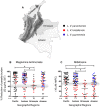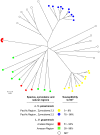Miltefosine and antimonial drug susceptibility of Leishmania Viannia species and populations in regions of high transmission in Colombia
- PMID: 24853871
- PMCID: PMC4031164
- DOI: 10.1371/journal.pntd.0002871
Miltefosine and antimonial drug susceptibility of Leishmania Viannia species and populations in regions of high transmission in Colombia
Abstract
Background: Pentavalent antimonials have been the first line treatment for dermal leishmaniasis in Colombia for over 30 years. Miltefosine is administered as second line treatment since 2005. The susceptibility of circulating populations of Leishmania to these drugs is unknown despite clinical evidence supporting the emergence of resistance.
Methodology/principal findings: In vitro susceptibility was determined for intracellular amastigotes of 245 clinical strains of the most prevalent Leishmania Viannia species in Colombia to miltefosine (HePC) and/or meglumine antimoniate (Sb(V)); 163, (80%) were evaluated for both drugs. Additionally, susceptibility to Sb(V) was examined in two cohorts of 85 L. V. panamensis strains isolated between 1980-1989 and 2000-2009 in the municipality of Tumaco. Susceptibility to each drug differed among strains of the same species and between species. Whereas 68% of L. V. braziliensis strains presented in vitro resistance to HePC, 69% were sensitive to Sb(V). Resistance to HePC and Sb(V) occurred respectively, in 20% y 21% of L. panamensis strains. Only 3% of L. V. guyanensis were resistant to HePC, and none to Sb(V). Drug susceptibility differed between geographic regions and time periods. Subpopulations having disparate susceptibility to Sb(V) were discerned among L. V. panamensis strains isolated during 1980-1990 in Tumaco where resistant strains belonged to zymodeme 2.3, and sensitive strains to zymodeme 2.2.
Conclusions/significance: Large scale evaluation of clinical strains of Leishmania Viannia species demonstrated species, population, geographic, and epidemiologic differences in susceptibility to meglumine antimoniate and miltefosine, and provided baseline information for monitoring susceptibility to these drugs. Sensitive and resistant clinical strains within each species, and zymodeme as a proxy marker of antimony susceptibility for L. V. panamensis, will be useful in deciphering factors involved in susceptibility and the distribution of sensitive and resistant populations.
Conflict of interest statement
The authors have declared that no competing interests exist.
Figures






Similar articles
-
Novel approach to in vitro drug susceptibility assessment of clinical strains of Leishmania spp.J Clin Microbiol. 2012 Jul;50(7):2207-11. doi: 10.1128/JCM.00216-12. Epub 2012 Apr 18. J Clin Microbiol. 2012. PMID: 22518860 Free PMC article.
-
Ex vivo host and parasite response to antileishmanial drugs and immunomodulators.PLoS Negl Trop Dis. 2015 May 29;9(5):e0003820. doi: 10.1371/journal.pntd.0003820. eCollection 2015 May. PLoS Negl Trop Dis. 2015. PMID: 26024228 Free PMC article.
-
Natural resistance to meglumine antimoniate is associated with treatment failure in cutaneous leishmaniasis caused by Leishmania (Viannia) panamensis.PLoS Negl Trop Dis. 2024 May 6;18(5):e0012156. doi: 10.1371/journal.pntd.0012156. eCollection 2024 May. PLoS Negl Trop Dis. 2024. PMID: 38709850 Free PMC article.
-
American tegumentary leishmaniasis in Brazil: a critical review of the current therapeutic approach with systemic meglumine antimoniate and short-term possibilities for an alternative treatment.Trop Med Int Health. 2019 Apr;24(4):380-391. doi: 10.1111/tmi.13210. Epub 2019 Feb 19. Trop Med Int Health. 2019. PMID: 30681239 Review.
-
Leishmaniasis in the major endemic region of Plurinational State of Bolivia: Species identification, phylogeography and drug susceptibility implications.Acta Trop. 2017 Dec;176:150-161. doi: 10.1016/j.actatropica.2017.07.026. Epub 2017 Jul 24. Acta Trop. 2017. PMID: 28751163 Review.
Cited by
-
Major changes in chromosomal somy, gene expression and gene dosage driven by SbIII in Leishmania braziliensis and Leishmania panamensis.Sci Rep. 2019 Jul 1;9(1):9485. doi: 10.1038/s41598-019-45538-9. Sci Rep. 2019. PMID: 31263131 Free PMC article.
-
Comparative analysis of the transcriptional responses of five Leishmania species to trivalent antimony.Parasit Vectors. 2021 Aug 21;14(1):419. doi: 10.1186/s13071-021-04915-y. Parasit Vectors. 2021. PMID: 34419127 Free PMC article.
-
Spatial distribution, Leishmania species and clinical traits of Cutaneous Leishmaniasis cases in the Colombian army.PLoS Negl Trop Dis. 2017 Aug 29;11(8):e0005876. doi: 10.1371/journal.pntd.0005876. eCollection 2017 Aug. PLoS Negl Trop Dis. 2017. PMID: 28850603 Free PMC article.
-
Targeting with Structural Analogs of Natural Products the Purine Salvage Pathway in Leishmania (Leishmania) infantum by Computer-Aided Drug-Design Approaches.Trop Med Infect Dis. 2024 Feb 3;9(2):41. doi: 10.3390/tropicalmed9020041. Trop Med Infect Dis. 2024. PMID: 38393130 Free PMC article.
-
Colombian Contributions Fighting Leishmaniasis: A Systematic Review on Antileishmanials Combined with Chemoinformatics Analysis.Molecules. 2020 Dec 3;25(23):5704. doi: 10.3390/molecules25235704. Molecules. 2020. PMID: 33287235 Free PMC article.
References
-
- Ait-Oudhia K, Gazanion E, Vergnes B, Oury B, Sereno D (2011) Leishmania antimony resistance: what we know what we can learn from the field. Parasitol Res 109: 1225–1232. - PubMed
-
- Tuon FF, Amato VS, Graf ME, Siqueira AM, Nicodemo AC, et al. (2008) Treatment of New World cutaneous leishmaniasis—a systematic review with a meta-analysis. Int J Dermatol 47: 109–124. - PubMed
-
- Soto J, Arana BA, Toledo J, Rizzo N, Vega JC, et al. (2004) Miltefosine for new world cutaneous leishmaniasis. Clin Infect Dis 38: 1266–1272. - PubMed
Publication types
MeSH terms
Substances
Grants and funding
LinkOut - more resources
Full Text Sources
Other Literature Sources
Medical

